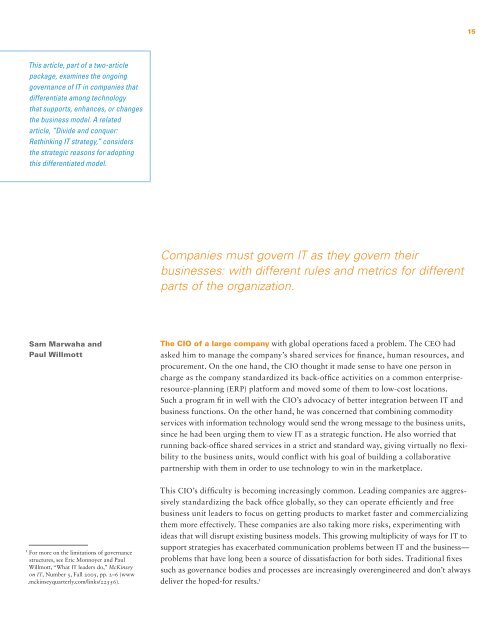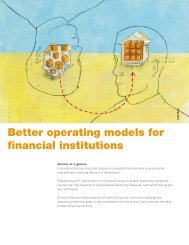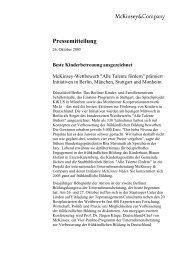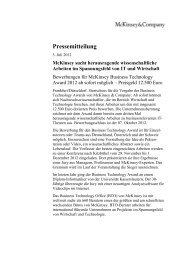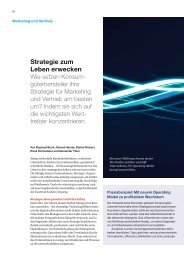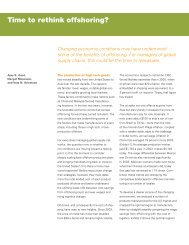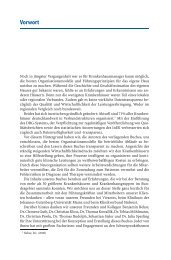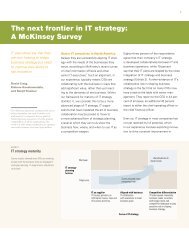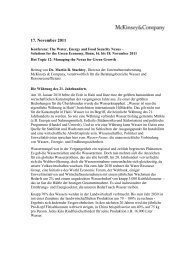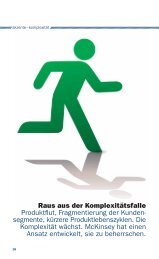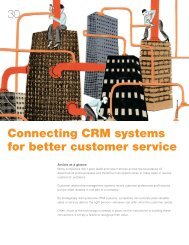Managing IT for scale, speed, and innovation - McKinsey & Company
Managing IT for scale, speed, and innovation - McKinsey & Company
Managing IT for scale, speed, and innovation - McKinsey & Company
You also want an ePaper? Increase the reach of your titles
YUMPU automatically turns print PDFs into web optimized ePapers that Google loves.
This article, part of a two-article<br />
package, examines the ongoing<br />
governance of <strong>IT</strong> in companies that<br />
differentiate among technology<br />
that supports, enhances, or changes<br />
the business model. A related<br />
article, “Divide <strong>and</strong> conquer:<br />
Rethinking <strong>IT</strong> strategy,” considers<br />
the strategic reasons <strong>for</strong> adopting<br />
this differentiated model.<br />
Sam Marwaha <strong>and</strong><br />
Paul Willmott<br />
1 For more on the limitations of governance<br />
structures, see Eric Monnoyer <strong>and</strong> Paul<br />
Willmott, “What <strong>IT</strong> leaders do,” <strong>McKinsey</strong><br />
on <strong>IT</strong>, Number 5, Fall 2005, pp. 2–6 (www<br />
.mckinseyquarterly.com/links/22556).<br />
Companies must govern <strong>IT</strong> as they govern their<br />
businesses: with different rules <strong>and</strong> metrics <strong>for</strong> different<br />
parts of the organization.<br />
The CIO of a large company with global operations faced a problem. The CEO had<br />
asked him to manage the company’s shared services <strong>for</strong> finance, human resources, <strong>and</strong><br />
procurement. On the one h<strong>and</strong>, the CIO thought it made sense to have one person in<br />
charge as the company st<strong>and</strong>ardized its back-office activities on a common enterprise-<br />
resource-planning (ERP) plat<strong>for</strong>m <strong>and</strong> moved some of them to low-cost locations.<br />
Such a program fit in well with the CIO’s advocacy of better integration between <strong>IT</strong> <strong>and</strong><br />
business functions. On the other h<strong>and</strong>, he was concerned that combining commodity<br />
services with in<strong>for</strong>mation technology would send the wrong message to the business units,<br />
since he had been urging them to view <strong>IT</strong> as a strategic function. He also worried that<br />
running back-office shared services in a strict <strong>and</strong> st<strong>and</strong>ard way, giving virtually no flexi-<br />
bility to the business units, would conflict with his goal of building a collaborative<br />
partnership with them in order to use technology to win in the marketplace.<br />
This CIO’s difficulty is becoming increasingly common. Leading companies are aggres-<br />
sively st<strong>and</strong>ardizing the back office globally, so they can operate efficiently <strong>and</strong> free<br />
business unit leaders to focus on getting products to market faster <strong>and</strong> commercializing<br />
them more effectively. These companies are also taking more risks, experimenting with<br />
ideas that will disrupt existing business models. This growing multiplicity of ways <strong>for</strong> <strong>IT</strong> to<br />
support strategies has exacerbated communication problems between <strong>IT</strong> <strong>and</strong> the business—<br />
problems that have long been a source of dissatisfaction <strong>for</strong> both sides. Traditional fixes<br />
such as governance bodies <strong>and</strong> processes are increasingly overengineered <strong>and</strong> don’t always<br />
deliver the hoped-<strong>for</strong> results. 1


